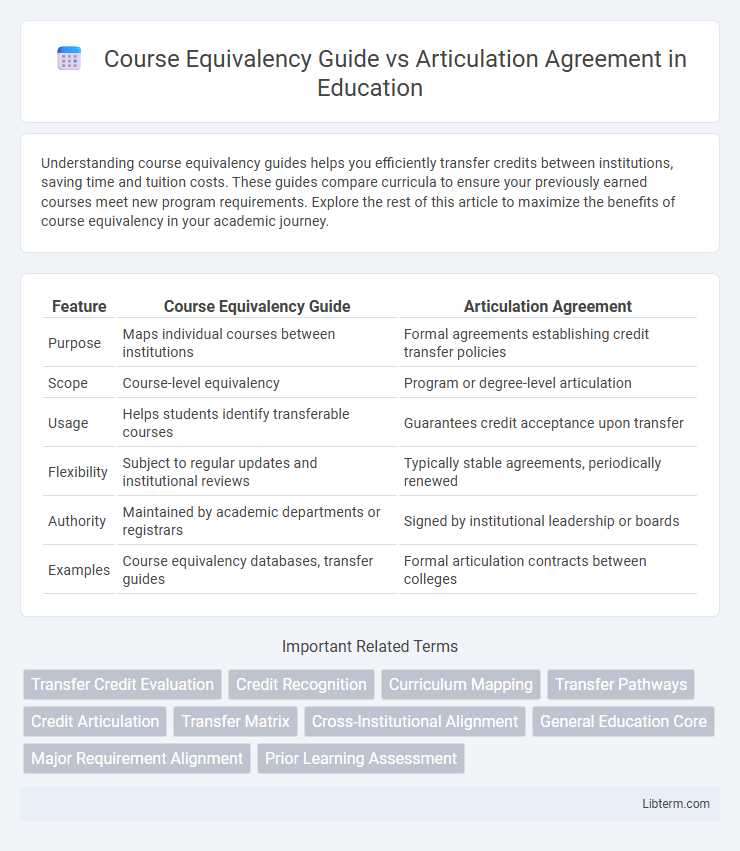Understanding course equivalency guides helps you efficiently transfer credits between institutions, saving time and tuition costs. These guides compare curricula to ensure your previously earned courses meet new program requirements. Explore the rest of this article to maximize the benefits of course equivalency in your academic journey.
Table of Comparison
| Feature | Course Equivalency Guide | Articulation Agreement |
|---|---|---|
| Purpose | Maps individual courses between institutions | Formal agreements establishing credit transfer policies |
| Scope | Course-level equivalency | Program or degree-level articulation |
| Usage | Helps students identify transferable courses | Guarantees credit acceptance upon transfer |
| Flexibility | Subject to regular updates and institutional reviews | Typically stable agreements, periodically renewed |
| Authority | Maintained by academic departments or registrars | Signed by institutional leadership or boards |
| Examples | Course equivalency databases, transfer guides | Formal articulation contracts between colleges |
Introduction to Course Equivalency and Articulation Agreements
Course equivalency guides provide detailed comparisons of specific courses across institutions to determine academic credit transferability, ensuring students receive recognition for prior learning. Articulation agreements are formal, institution-to-institution contracts outlining agreed-upon pathways for credit transfer and program progression, often supporting seamless transitions between community colleges and universities. Both tools facilitate academic planning, but course equivalency guides emphasize course-level matching while articulation agreements focus on broader program alignment.
Defining Course Equivalency Guide
A Course Equivalency Guide is a comprehensive resource used by academic institutions to compare and match courses from different schools, ensuring that credits earned elsewhere meet specific program requirements. It details how coursework from other colleges aligns with the institution's curriculum, facilitating transfer students in understanding which courses are accepted for credit. This guide focuses solely on course-by-course equivalency rather than formal partnerships between institutions, distinguishing it from articulation agreements.
What Is an Articulation Agreement?
An articulation agreement is a formal partnership between two or more educational institutions that guarantees the transfer of specific credits from one school to another, ensuring students can continue their education without losing progress. It outlines which courses or programs are accepted for transfer and helps streamline the transition between different colleges or universities. This agreement provides clarity on credit recognition and supports academic planning for students pursuing advanced degrees or certifications.
Purpose and Importance of Course Equivalency Guides
Course Equivalency Guides serve as essential tools for students and academic advisors to identify how courses from different institutions compare in content and credit value, facilitating smooth credit transfer. These guides enable accurate course substitutions, minimizing lost credits and reducing time to degree completion. Their importance lies in supporting informed decision-making for transfer students and maintaining academic consistency across educational institutions.
How Articulation Agreements Work
Articulation agreements are formal partnerships between two or more educational institutions that specify which courses will be accepted for credit, ensuring smooth transferability for students. These agreements clearly map out course equivalencies to guarantee that credits earned at one institution fulfill specific program requirements at another. By standardizing credit recognition, articulation agreements streamline the transfer process and minimize course duplication.
Key Differences Between Course Equivalency Guides and Articulation Agreements
Course equivalency guides provide detailed mappings of specific courses between institutions, showing which classes are considered equal for credit transfer purposes. Articulation agreements are formal, institutional contracts that outline broader transfer pathways, including program requirements and guaranteed admissions policies. While course equivalency guides focus on individual course comparisons, articulation agreements establish overarching frameworks for student transfer and degree progression.
Benefits of Using Course Equivalency Guides
Course Equivalency Guides streamline the transfer process by providing clear, institution-specific mappings of courses, ensuring students know exactly which credits will transfer between schools. These guides enhance academic planning and reduce credit loss, saving time and tuition fees by preventing redundant coursework. Access to detailed course equivalencies fosters smoother credit evaluation and quicker degree completion for transfer students.
Advantages of Articulation Agreements for Students
Articulation agreements provide students with clear, guaranteed pathways for credit transfer between institutions, reducing uncertainty and simplifying the transfer process. These agreements ensure that completed coursework directly fulfills program requirements at the receiving institution, saving time and tuition costs. Students benefit from enhanced academic planning support, increasing the likelihood of timely degree completion and successful transfer experiences.
How to Access and Interpret Course Equivalency Information
Access the Course Equivalency Guide through the university's registrar website, where searchable databases list exact course matches between institutions. Interpret course equivalency information by comparing course codes, credit units, and descriptions to confirm that the learning outcomes align with required program standards. Articulation agreements often provide supplementary context by outlining guaranteed transfer pathways, simplifying the evaluation of course transferability and credit acceptance.
Choosing the Right Resource: Equivalency Guide or Articulation Agreement?
Course Equivalency Guides provide detailed comparisons of individual courses between institutions, allowing students to identify specific class substitutions for transfer credits, while Articulation Agreements outline broader transfer pathways and degree requirements agreed upon by institutions. Selecting the right resource depends on whether the focus is on evaluating specific course matches or understanding comprehensive transfer frameworks for degree completion. Using both tools in tandem ensures accurate credit transfer and optimized academic planning during the transfer process.
Course Equivalency Guide Infographic

 libterm.com
libterm.com